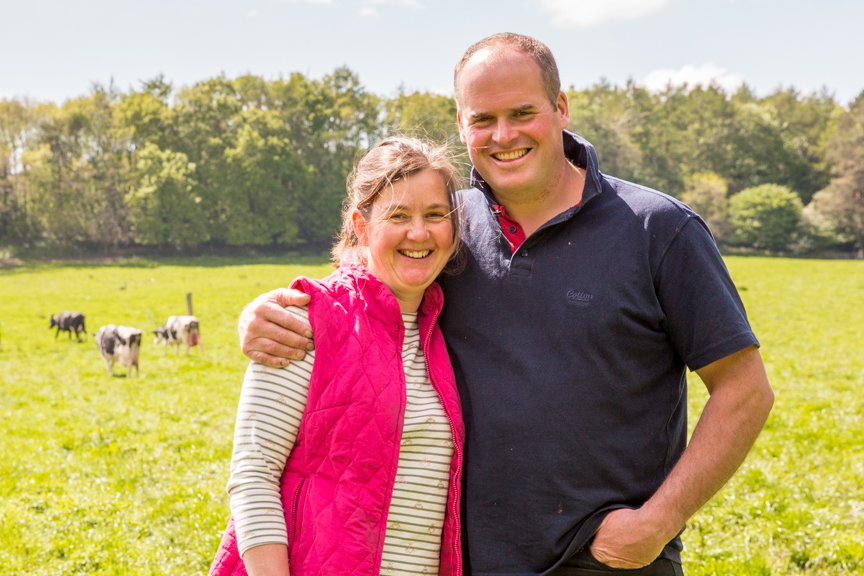Targeting cost of production at Rhual Dairy
Thursday, 4 February 2021
John and Anna Booth from Rhual Dairy achieve an impressive full economic cost of production of 28.2ppl, placing them just outside the top 5% of GB herds.
Setting and achieving a low cost of production target enables farms to become more resilient to market volatility and periods of low milk prices. Knowing your costs and understanding how you compare with others can highlight areas for improvement and improve overall profitability.
Based near Mold in North Wales, Rhual Dairy is home to a 336 Holstein/Friesian all year-round calving herd managed by John and Anna along with herdsman Aled Roberts.
John worked as a herd manager for Velcourt and Anna as a dairy consultant after graduating from Harper Adams. They moved to Rhual in 2001 and with solid dairy backgrounds, their data driven approach informs many of their management decisions.
In the last 20 years, they’ve grown stock numbers and output to 8,500 litres, as well as improving infrastructure with a new transition shed. Grassland, half of which is parkland, makes up 182ha of the farm’s 220ha with the rest a mix of maize and spring barley.
Find out more about Rhual Dairy
Each year, they benchmark cost of production figures on a comparable farm profit (CFP) with their local discussion group - The Udder Group. This gives them a more detailed understanding of their operations while learning from others and keeps them motivated to stay on track. They feel an annual review is sufficient since it can take 12 months for performance improvements to be effective.
The yearly exercise highlighted high bedding straw costs, so they bought a chopper to reduce the amount needed. They’ve further refined their approach to use crushed husks and bed up twice daily using an AG Maxi sawdust dispenser, which keeps costs low and the cows clean.
Feed bills typically represent at least 50% of a dairy unit's variable costs and over a quarter of its total costs. Add on labour, machinery and storage of home-grown feeds, plus the costs of delivering these to cows and feeding can amount to half a unit's entire annual cost.
Purchased concentrates are the largest outlay at Rhual - consistent with other British farms - and make up 7.34 pence per litre of their costs. In the last twelve months John and Anna have reduced this cost by 0.58ppl, which they achieved by securing more competitive concentrate prices with their buying group and reducing the blend fed without any loss in yield.
Read how Michael and Tony Ball lowered purhased feed costs
Grass self-sufficiency offers the biggest opportunity to save costs at Rhual. Further efficiencies could be made by organising cows in lactation groups and tailoring their feed according, but this isn’t feasible due to the farm set-up.
Increasing milk yield from forage from their current 2,156 litres to 3,500 litres will reduce their reliance on concentrates and utilise more grass in the herd’s diet. To help them measure grass quantity and make better grazing decisions they’ve bought a rising plate meter for the 2021 grazing season.
John and Anna see value in weekly reviews with Gwyn Jones from Wern Vets, which explains why their vet and med costs are high compared with other farms. Discussions consider cow welfare and herd health targets as well as practical matters. This preventative approach means they rarely make emergency calls to the vet.
As a share farm, their mindset is keenly focused on driving costs down to deliver a profit. Membership of a buying group enables them to shop around for cow concentrates in July and secure six months’ stock at an affordable price.
Rhual sits within a Nitrate Vunerable Zone (NVZ) so Anna completes a crop requirement plan each year. They soil sample every four years, which considers slurry application and fertiliser needs to meet RB209 recommendations. They purchased a trailing shoe slurry tanker to make the best use of their own slurry, while reduce fertiliser usage and helping the environment. Fertiliser is forward ordered to secure good costs.
John sums up their approach: “Figures drive us, we use performance data and benchmarking to guide us to make the best management decisions for our farm.
“We keep a sharp eye on our costings, we review it regularly and take part in an annual benchmarking group to keep us focused and motivated to control our costs.”

Topics:
Sectors:
Tags:

